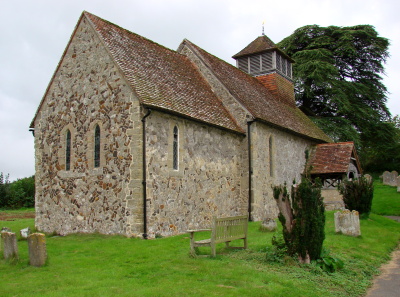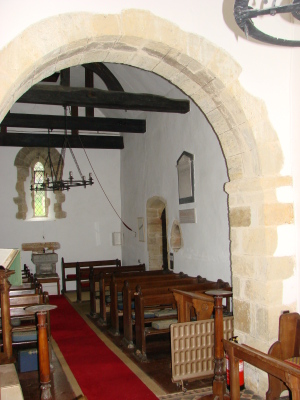Coates – St Agatha
A small C12 aisleless church, unaltered except for the insertion of C13 lancets and a large belfry of 1907.
Coates, one of the remotest and least documented mediaeval churches in Sussex, lies in the wooded country south east of Petworth. The benefice has been united with Burton since 1510 (Hussey p217).
The aisleless nave and short chancel are C12, as the round-headed chancel arch shows. Though plain, with slightly chamfered abaci, its date is shown by its size and relatively broad proportions in such a small church. A window of this date in the south wall of the nave has a head fashioned from a single stone and suggests the church dates from fairly early in the century.
The chancel was never extended, though as in the nave, early C13 lancets were inserted. Their round-headed rere-arches and the lack of scoinsons are both indicators of the date, whilst the sill of the south one has been lowered to form a sedile. The nave rere-arches have lost their heads save the renewed west one, but there is no reason to doubt that they are of the same date. Like other churches in the area (e g Barlavington) there are two east lancets, not the more usual three. The roofs are plastered but retain old timbers. In the nave are kingposts, one with upward braces, and the belfry is supported by queenposts on a beam. The Sharpe Collection drawing (1804) shows a small, weather-boarded belfry.
The open timber north porch (in part at least) and moulded doorway with a depressed head look C16. The restoration by an unknown architect in 1907, stated on a plaque in the church to have been done in memory of the Duchess of Abercorn of Coates Castle, veers between sensitivity and the reverse. The exterior was repointed in hard cement and was in part refaced (see in particular the east wall of the chancel). The disproportionately large belfry is also of this date, though in 1961 a taller spirelet was replaced by a cap more like that before 1907 (BE p192). By contrast, the interior has considerable charm, though the effect of contrasting white plaster and dark stonework must date from the restoration.
Fittings
Font: (Set against the west wall) C12. A good example of the standard type of square arcaded marble bowl with four corner shafts and a thicker centre stem. The corner shafts have bases only.
Glass: (East window) C E Kempe, 1898.
Stoup: (Close to the north doorway) Probably of the same date as the doorway, i e early C16.
Reredos: (Formerly) J Wippell and Co, London, 1908 (WSRO Ep I/40/4396).



